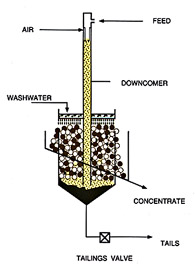
Jameson Cell ore process
1985
improved flotation process for ore separation
Here's a new version of an old Australian mining innovation.
The froth flotation process is used to separate minerals from ores at metal mines around the world. Mineral ores are ground into small particles and put into chemical baths (called cells). Air bubbles are forced up through the cell and the mineral particles stick to them. The bubbles form a mineral-rich froth on the surface, which is then scraped off.
In the 1980s a new kind of flotation cell was developed by Professor Graeme Jameson and students at the University of Newcastle. Crushed ore, in a liquid slurry, is fed into a vertical pipe and draws air down with it. Mixing and adhesion occur more quickly and in a smaller space than in a conventional cell. This improves the separation and collection process. A higher percentage of mineral is recovered, improving the economics of a mine; this also means that less mineral is left in the tailings, from where heavy metals could leach into the soil and pose a hazard.
As there is no need for a motor, air compressor or moving parts, the new cells are energy efficient and cheap to operate and maintain.
After trialling and further development at Mount Isa Mines in the mid 1980s, Jameson Cells were installed at mine sites in several countries to improve recovery rates of lead, zinc, copper, nickel and other ores. They are also used to recover fine coal that would otherwise go to waste.
Who Did It?
Key Organisations
MIM Holdings Pty Ltd : development
University of Newcastle : research
Key People
Graeme Jameson : inventor
Jim Fewings : development team leader
Further Reading
'The Jameson Flotation Cell'
Alan Kennedy
Mining Magazine, October 1990
Links
MIM Process Technologies, Jameson
Cell
MIM Holdings
Minerals Council of Australia
Related Innovations
Froth flotation process
|










